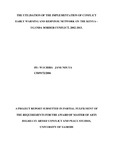| dc.description.abstract | Generally, the aim of conflict early warning is to identify critical developments in a timely manner so that coherent response strategies can be formulated to either prevent violent conflict or limit its destructive effects. The Conflict Early Warning and Response Network was created by the Inter-Governmental Authority on Development member states to systematically anticipate violent conflicts in the region and respond in a timely and effective manner.
However, Kenya and Uganda still experience non-cordial relations as a result of cross-border conflicts emanating from grazing and water points, livestock rustling, refugees, banditry, smuggling and illegal trade. It is against this backdrop that this research sought to assess the utilization CEWARN on Kenya-Uganda border relations.
The study addresses the Kenya-Uganda cross-border conflict issues which, if not curtailed, could plunge the two nations into violent conflicts. Its objectives were to investigate the utilization of CEWARN on Kenya-Uganda border conflict, to establish the role of political, social, historical, economic, environmental and cultural factors in causing conflict along the border, plus analyzing the practical intervention options available to IGAD decision makers for CEWARN implementation.
In undertaking the study, the descriptive survey design was used. The main purpose was to collect information on the use of CEWARN on the Kenya and Uganda border conflict. Also purposive sampling technique was used whereby the researcher purposely targeted a group of people believed to be knowledgeable about the topic. The sample comprised of NGOs, CBOs, FBOs, MoFAs, Government officials, District peace committees and opinion leaders from the communities. And data was collected using questionnaires and interview schedules.
v
Two theories were used to achieve the objective, human needs theory and conflict resolution theory by John Burton. He says that human beings have basic needs and if needs aren‟t met, this can lead to conflict.
Along Kenya and Uganda border, conflict is caused by resource competition, cattle rustling and availability of small arms. The conflicts have had a negative impact and severe impact on the communities such as loss of human life, destruction of property, displacement of people and underdevelopment in these regions.
The study has shown that Civil Society Organisations Kenya and Uganda governments, African Union, Community Based Organisations and Churches have attempted to prevent and mitigate violent conflict along the border. This is by developing mediation and conflict prevention capacities of the communities involved, disarmament and establishing projects.
Also the study shows that CEWARN data has been very instrumental in conflict prevention along Kenya and Uganda border. The use of ICT4 peace project has led to faster transfer of information from region to another. The HF radios have been used to transmit early warning information. Consequently, there have been success stories of conflict prevention because of the timely information received through the radio and telephone calls.
The study had three hypothesis which were tested which were, low utilisation of CEWARN on Kenya and Uganda border has led to continued conflict, political, economic, cultural and environmental factors have contributed to conflict and practical intervention by IGAD decision makers in implementation of CEWARN is the key to peace along the border
Conflict prevention and management is important for peace, security and development. There is an urgent need, therefore, for sustained cross-border co-operation that goes beyond security issues and tackles the root causes of conflict. | en_US |

